 We took our first trip to the Jemez Mountains last Thursday to start woodcutting for the winter. When we got there we had to sit in the truck and wait for a rain shower to pass before we could start cutting. After the rain I noticed this nice pine tree with lots of green moss on the left side and the log and rock at it's base to make a nice photo.
We took our first trip to the Jemez Mountains last Thursday to start woodcutting for the winter. When we got there we had to sit in the truck and wait for a rain shower to pass before we could start cutting. After the rain I noticed this nice pine tree with lots of green moss on the left side and the log and rock at it's base to make a nice photo.Monday, December 21, 2009
In the Woods
 We took our first trip to the Jemez Mountains last Thursday to start woodcutting for the winter. When we got there we had to sit in the truck and wait for a rain shower to pass before we could start cutting. After the rain I noticed this nice pine tree with lots of green moss on the left side and the log and rock at it's base to make a nice photo.
We took our first trip to the Jemez Mountains last Thursday to start woodcutting for the winter. When we got there we had to sit in the truck and wait for a rain shower to pass before we could start cutting. After the rain I noticed this nice pine tree with lots of green moss on the left side and the log and rock at it's base to make a nice photo.Saturday, December 19, 2009
Cycling Indoors: the Kurt Kinetic Trainer
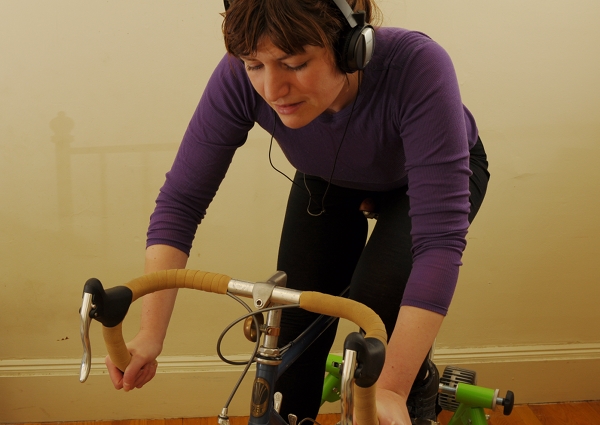 Last month I asked for advice about bicycle trainers, but after reading all the comments decided not to get one after all. It was the promise of horrific boredom that dissuaded me: I didn't want to get a trainer and then end up never using it. But several blizzards and several yards of snow later, I once again found myself climbing the walls and thinking that any way to be on my roadbike would surely do. My birthday is coming up, and so I asked the Co-Habitant to get me a trainer as an early gift - requesting that he do all the obsessive gadget research himself, and just present me with it as soon as possible.
Last month I asked for advice about bicycle trainers, but after reading all the comments decided not to get one after all. It was the promise of horrific boredom that dissuaded me: I didn't want to get a trainer and then end up never using it. But several blizzards and several yards of snow later, I once again found myself climbing the walls and thinking that any way to be on my roadbike would surely do. My birthday is coming up, and so I asked the Co-Habitant to get me a trainer as an early gift - requesting that he do all the obsessive gadget research himself, and just present me with it as soon as possible.He was suspicious at first."You want a trainer. For your birthday? Are you sure that's a sufficiently ...romantic gift?"
"It's a fine gift. Totally romantic. Just get it for me, please."
 And so, since last week I have been the owner of aKurt Kinetic Road Machine Fluid Trainer. The model was on sale at the Wheelworks in Somerville, MA (they had four left as of last week), and the opportunity was ceased. It is lime green and in no way blends in with any normal household decor. It is a good thing we have a "bohemian" apartment where pretty much anything goes, including a bike plugged into a neon contraption in the middle of the bedroom.
And so, since last week I have been the owner of aKurt Kinetic Road Machine Fluid Trainer. The model was on sale at the Wheelworks in Somerville, MA (they had four left as of last week), and the opportunity was ceased. It is lime green and in no way blends in with any normal household decor. It is a good thing we have a "bohemian" apartment where pretty much anything goes, including a bike plugged into a neon contraption in the middle of the bedroom.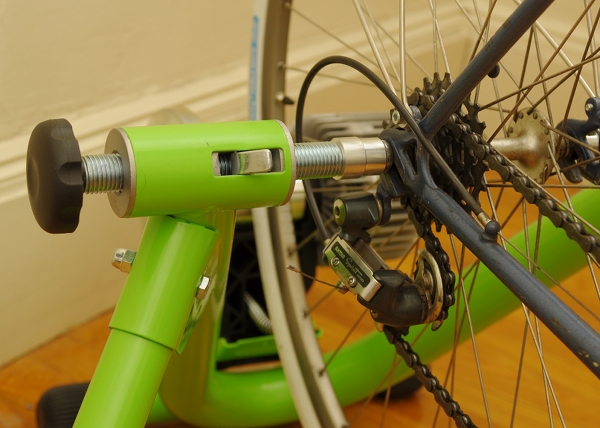 To set up the trainer, you have to attach the rear wheel of the bicycle using a special skewer, so that the tire rests firmly against the mechanism which provides resistance. I would describe the set-up process as somewhat tricky: You have to align the wheel just right and tighten everything just so.
To set up the trainer, you have to attach the rear wheel of the bicycle using a special skewer, so that the tire rests firmly against the mechanism which provides resistance. I would describe the set-up process as somewhat tricky: You have to align the wheel just right and tighten everything just so. As you pedal, the resistance from the trainer is similar to the resistance you feel when cycling on the road.Beyond that, I admit that I have no idea how it works, and am not particularly curious as long as it does the job.Some prefer to put a block or a riser under the front wheel, but I feel fine without it.
As you pedal, the resistance from the trainer is similar to the resistance you feel when cycling on the road.Beyond that, I admit that I have no idea how it works, and am not particularly curious as long as it does the job.Some prefer to put a block or a riser under the front wheel, but I feel fine without it. To me, using the trainer emulates the cycling experience realistically insofar that I am on an actual bike, and that the sensation of pedaling really does feel like being on the road. What's different, is that the bicycle doesn't lean, as would have been natural on the road, and - oh yes - that I am in my bedroom, staring at a wall and going absolutely nowhere. After the first time I used the trainer, it became clear that I needed visual stimuli - music alone was not sufficient to counteract the mind-numbing effect of looking at nothing.
To me, using the trainer emulates the cycling experience realistically insofar that I am on an actual bike, and that the sensation of pedaling really does feel like being on the road. What's different, is that the bicycle doesn't lean, as would have been natural on the road, and - oh yes - that I am in my bedroom, staring at a wall and going absolutely nowhere. After the first time I used the trainer, it became clear that I needed visual stimuli - music alone was not sufficient to counteract the mind-numbing effect of looking at nothing. So I rigged up this "tower" using two wooden chairs (don't worry, they are very stable), which allowed me to place my laptop at eye level.
So I rigged up this "tower" using two wooden chairs (don't worry, they are very stable), which allowed me to place my laptop at eye level. Thank goodness for Netflix and enormous earphones. The trainer is fairly quiet to begin with (the sound it makes is a sort of low hum - not high pitched or annoying), and if I had a TV rather than a tiny laptop, I don't think earphones would even be necessary. But the nice thing about using them, is that they drown out the sound of the trainer entirely, making it easier to get absorbed in the film and put my legs on autopilot.
Thank goodness for Netflix and enormous earphones. The trainer is fairly quiet to begin with (the sound it makes is a sort of low hum - not high pitched or annoying), and if I had a TV rather than a tiny laptop, I don't think earphones would even be necessary. But the nice thing about using them, is that they drown out the sound of the trainer entirely, making it easier to get absorbed in the film and put my legs on autopilot. It took me a couple of days on the trainer to learn how to pace myself. I guess on the road, there are factors that control my speed - traffic lights, obstacles, turns, and even just fear. With these factors gone, I had to keep forcing myself to slow down, so as not to get exhausted immediately. Watching a movie helps, because my pedaling starts to sync up with the highs and lows of the film - slowing down during the quiet parts and speeding up during the exciting parts. At the moment, I am able to keep going for 40 minutes at a time before needing to stop, but I am hoping to make it an hour by next week.
It took me a couple of days on the trainer to learn how to pace myself. I guess on the road, there are factors that control my speed - traffic lights, obstacles, turns, and even just fear. With these factors gone, I had to keep forcing myself to slow down, so as not to get exhausted immediately. Watching a movie helps, because my pedaling starts to sync up with the highs and lows of the film - slowing down during the quiet parts and speeding up during the exciting parts. At the moment, I am able to keep going for 40 minutes at a time before needing to stop, but I am hoping to make it an hour by next week.  I don't want to give the impression that the trainer is anything other than what it is - a device that allows you to pedal your own bicycle as it remains stationary. The experience does not even begin to compare to "real" roadcycling, which to me is much more about exploration than about exercise. But if I approach it from the other end, and start with the given of wanting indoor exercise that emulates cycling, this trainer pretty much fits the bill. Having never tried others I can't compare, but the Kurt Kinetic trainer does everything I imagined a trainer doing, and it is quieter than I had hoped.
I don't want to give the impression that the trainer is anything other than what it is - a device that allows you to pedal your own bicycle as it remains stationary. The experience does not even begin to compare to "real" roadcycling, which to me is much more about exploration than about exercise. But if I approach it from the other end, and start with the given of wanting indoor exercise that emulates cycling, this trainer pretty much fits the bill. Having never tried others I can't compare, but the Kurt Kinetic trainer does everything I imagined a trainer doing, and it is quieter than I had hoped.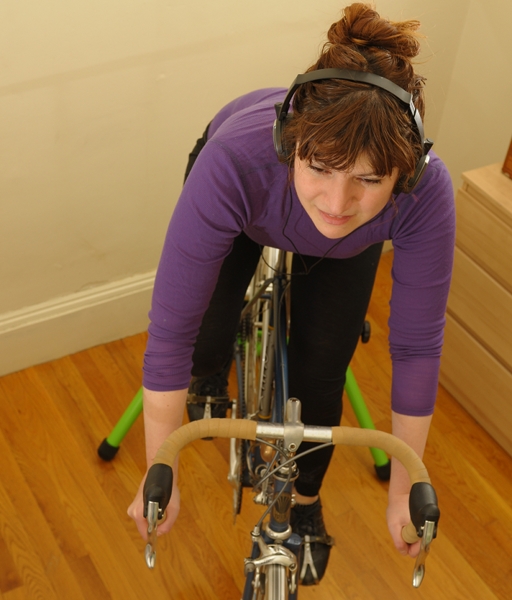 I think I have to face it that something in me has changed over the past year, and I now feel that my body "needs" strenuous exercise. I never thought that would happen to me, and I don't understand human physiology well enough to know how that works. All I know is, that I've been on a roadbike every day for the past week and I am feeling a little more like myself again. It's indoors, it's stationary and it's not real cycling - but I'll take it.
I think I have to face it that something in me has changed over the past year, and I now feel that my body "needs" strenuous exercise. I never thought that would happen to me, and I don't understand human physiology well enough to know how that works. All I know is, that I've been on a roadbike every day for the past week and I am feeling a little more like myself again. It's indoors, it's stationary and it's not real cycling - but I'll take it.
Tuesday, December 15, 2009
Dream Wool Cycling Jersey Concept
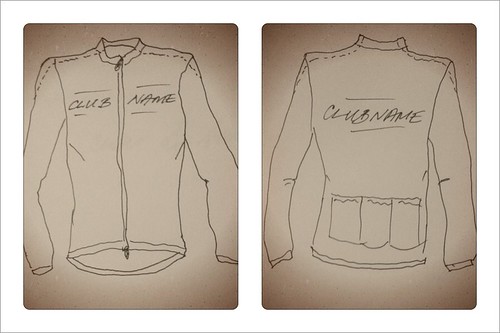
A number of manufacturers have come out with updated versions of the classic wool roadcycling jersey over the past few years, and I've accumulated a few. All have some nice features, but none are perfect. Yesterday I noticed one that I think might come close, and exchanged some emails with my Ibex contact Julie lamenting that there is no women's version. This ended with the people at Ibex saying they will consider it for Fall , which, in turn, inspired me to be more specific about what I envisioned. This is not directed at Ibex necessarily, but at wool manufacturers in general. It is a simple concept, and shouldn't be difficult to execute - yet no jersey quite like this exists at the moment as far as I know.

The key to my dream wool cycling jersey is a very lightweight merino fabric. And by lightweight I mean summer weight, t-shirt weight. The wool Swobo and Woolistic use for their jerseys is too heavy. Rapha, Road Holland and Shutt Velo Rapide use "sport wool," which is a wool/polyester blend that, for me at least, works nicely over a base layer in cold temps, but not against bare skin. Icebreaker adds a touch of lycra to their paper-thin wool jerseys for stretch, and I like their fabric as a possibility. But the nicest I've worn so far has been the 18.5 micron, 195g/m2 merino used by Ibex for their Indie line of jerseys. That fabric feels pretty much spot on.
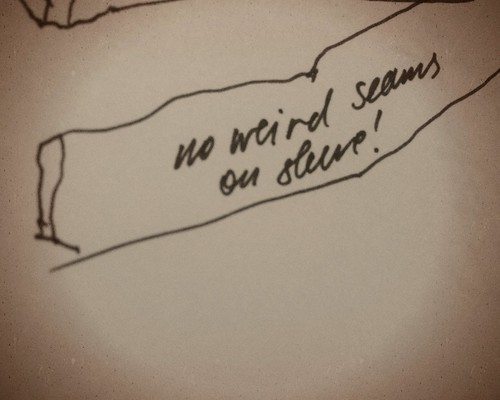 I prefer cycling jerseys with long sleeves, even in summer, because this way my arms don't get burned. Also, if the fabric is lightweight enough, I actually find it more comfortable to have my skin covered in the heat than not. The combination of the t-shirt weight wool and the long sleeve length is perfect for temperature regulation on both hot and cool days.One thing to add here, is that I beg whoever makes this jersey to not do anything crazy to the sleeves - like what Swobo did here by adding seams. I have both the older (no seams) and the newer (seams! why?) versions of their long sleeve jersey, and the seams on the newer one make the sleeves constricting. Please just leave the sleeves be; they don't need reinventing.
I prefer cycling jerseys with long sleeves, even in summer, because this way my arms don't get burned. Also, if the fabric is lightweight enough, I actually find it more comfortable to have my skin covered in the heat than not. The combination of the t-shirt weight wool and the long sleeve length is perfect for temperature regulation on both hot and cool days.One thing to add here, is that I beg whoever makes this jersey to not do anything crazy to the sleeves - like what Swobo did here by adding seams. I have both the older (no seams) and the newer (seams! why?) versions of their long sleeve jersey, and the seams on the newer one make the sleeves constricting. Please just leave the sleeves be; they don't need reinventing.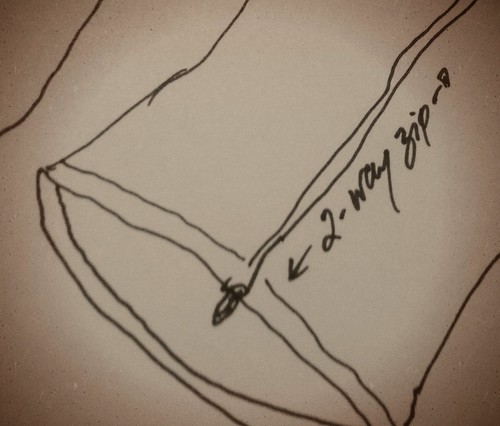
One feature I would absolutely love to see in a cycling jersey is a 2-way zipper. I think this would be an especially useful feature for women, as it would enable us to unzip the jersey for extra ventilation just like men do, but without exposing the bosom. With a 2-way zipper we can unzip along the tummy and leave the chest covered up. I am surprised no one has tried this yet actually. The zipper should be covered on the inside of the jersey, so that it doesn't come into contact with the skin.
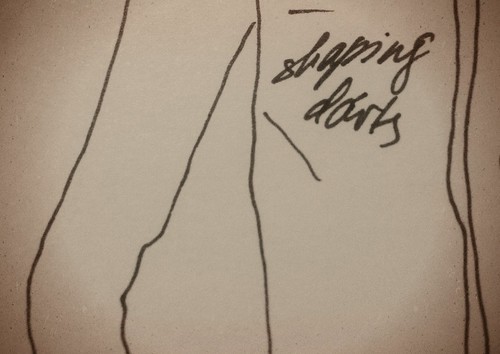
Women sometimes complain that cycling jerseys are unflattering, and one way to remedy this would be to tailor the jersey via shaping darts - which Ibex already does in some of their athletic tops. However, I am reluctant to suggest this, because it does introduce additional seams which for some may cause chafing. Personally I am okay with or without darted tailoring, though a women-specific fit would be nice.
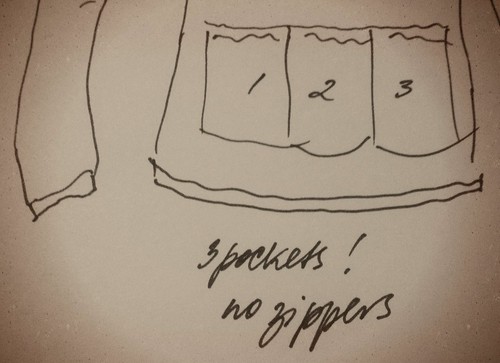
In the back, all I want is the classic 3 jersey pockets, elasticized at the top. No more or no less; no bells and whistles; nothing weird. Some manufacturers have been getting clever with the pockets - adding all sorts of secret zip-up compartments for pumps and wallets, which I really feel is unnecessary, and if anything, limits the use of that potentially vast pocket space. Just the standard 3 pockets please!
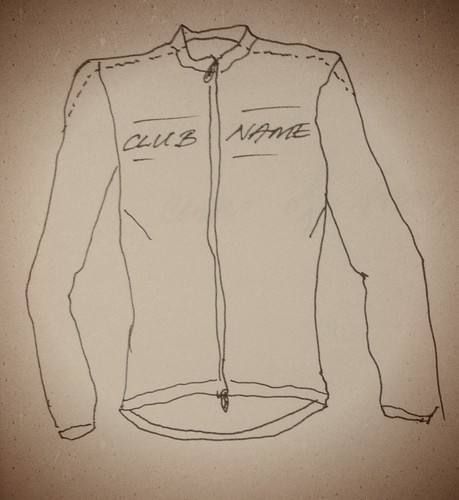
As far as looks, I am open - just please keep it simple. No flowers, no swirly shapes, no faux-oriental designs, and no clever slogans. Classic colours. Maybe a stipe or two somewhere, with room for embroidering a club name across the chest and back. I love this colourscheme from Ibex, and these from Rapha (sans prominent logo), and this one from Shutt Velo Rapide - and of course these vintage beauties from Bridgestone. Less is more, and a couple of contrasting stripes go a long way.

I have not described anything complicated here, and I hope manufacturers reading this will consider producing something like it. Ibex is probably in the best position to do it, because they already have the perfect fabric and a design that comes very close. But I'd love to see more options for lightweight, women-specific wool cycling jerseys across the board. Your thoughts and input are, of course, welcome. Who knows, maybe we can make something happen.
Thanksgiving Snow

Minnesota Northwoods on Thanksgiving Day, - Grand Portage, MN. A different world from the shoreline of Lake Superior where only an inch or two of snow had fallen, a few miles inland was a different story. Here nearly a foot of freshly fallen snow blanketed the landscape on Thanksgiving Day!
Friday, December 11, 2009
What's in a Cycling Cap?
 I was in the Ride Studio Cafe the other day, when a woman came in to buy a cycling cap. She was already wearing a cap - one that looked to be from the early '80s, faded yellow with "world champion" rainbow stripes. She looked around the shop and tried on several of the caps they sell, but seemed restless and her eyes kept wandering over to me. I was wearing a white cap with rainbow stripes, very much like her own only newer. Before she even approached me, I could sense that she was attracted to my cap. I thought that she was going to ask me where I bought it. Instead she asked if she could have it, buying me a Rapha hat as a replacement.
I was in the Ride Studio Cafe the other day, when a woman came in to buy a cycling cap. She was already wearing a cap - one that looked to be from the early '80s, faded yellow with "world champion" rainbow stripes. She looked around the shop and tried on several of the caps they sell, but seemed restless and her eyes kept wandering over to me. I was wearing a white cap with rainbow stripes, very much like her own only newer. Before she even approached me, I could sense that she was attracted to my cap. I thought that she was going to ask me where I bought it. Instead she asked if she could have it, buying me a Rapha hat as a replacement.So that is how I came to be in possession of my very own article of Rapha clothing that I'd critiqued only a week earlier. It's (even) less flattering to my face than my other cap, though admittedly it works better under a roadcycling helmet and the fabric and stitching are of higher quality. But more than anything, I like the unusual manner in which I acquired it. Sometimes an item can serve as a memento of a day or a social exchange, attaining the status of a personal keepsake.
Cycling caps are a very particular design that has become iconic: The skull-hugging panel construction, the small visor that flips up, the racing stripes. I don't think that any of the variations look especially good on most people, but their symbolism seems to hold at least as much appeal as their objective attractiveness or their cycling-specific usefulness. I would bet that the sale of cycling caps went up when Breaking Away came out, as well as more recently, when the Yehuda Moon comic became popular.
On a personal level, a specific cap might remind us of an experience associated with cycling that was exciting, formative or inspiring. Maybe our favourite racer wore one just like it. Or the cool older kid in the neighbourhood used to ride his bike around wearing one. At some point I realised that one of my first memories of my father involved a cycling cap. He is not a cyclist, but it was popular to wear them in Europe in the '80s, especially on the beach. I have a very clear memory of him sitting on a blanket and sipping beer while watching my mother swim in the sea, wearing a cycling cap with the visor flipped up. It was either yellow or white, and it definitely had the "world champion" rainbow stripes. Funny.
When the woman at the RSC asked for my cap, I had the distinct feeling that it reminded her of something, and it made sense to give it to her. But I will probably buy myself another one at some point: Those rainbow stripes remind me of Europe in the early '80s, of vintage bikes, and of childhood days at the beach.
Tuesday, December 8, 2009
Dutch Bike: Impressions After an Absence
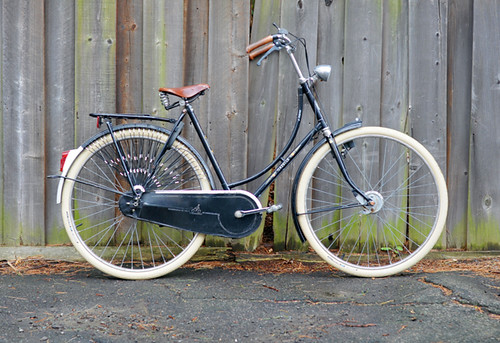
I own a 15 year old Gazelle A-Touren that is pretty much the prototypical Dutch bike. It was my main city bike for a while, until I put it in storage last November. Yesterday I retrieved the Gazelle (
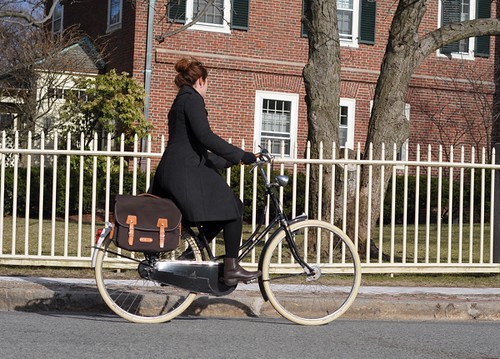
My first impression of the Gazelle upon our reunion had to do with the riding position. I forgot that it was even possible to be sitting that upright on a bicycle! I consider my other 3-speed and my mixte to be upright bikes as well, but they are certainly not compared to the Gazelle. The rider's position on this bike is akin to sitting in a chair: back straight, shoulders relaxed, hands holding the bars in much the same manner as one would hold an open newspaper or a tray.
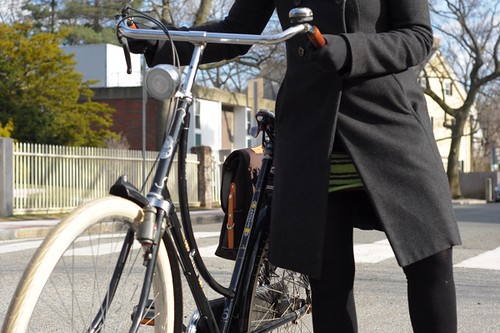
The handlebars are dramatically swept back and very close to the body. There is no feeling of reaching at all - my hands just basically rest on the bars naturally if I simply plop them down, bent at the elbows. This also means that there is very little weight being placed on the handlebars, or on the front end of the bike at all for that matter.
The unweighted front end was a sensation that took getting used to after an absence. However, it was really just a matter of training my body to adjust to it. After circling the block a few times and picking up speed, the handling already began to feel intuitive again. With the handlebars way behind the font hub, this is not a super-responsive bicycle. There is almost a feeling of passivity or detachment in riding it, like being in the back seat of a vehicle instead of the driver's seat.
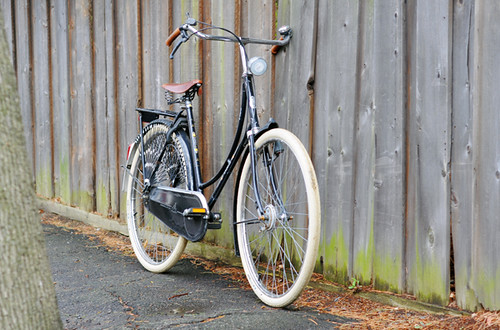
These factors combined are what's responsible for the "regal" feeling associated with riding a Dutch bike. The effortlessness, the perfect posture, the ability to observe one's surroundings in a way that cannot be done on other bikes - it all encourages a relaxed and confident attitude. The wide 28" tires create a plush ride quality that further contributes to the luxurious feel. The nuisance of potholes and rough road surfaces need not trouble the rider. As I rode the Gazelle around the neighborhood, it felt as if I were sailing aboard a luxury liner more than riding a bike. I had completely forgotten that sensation.
Of course another thing I'd forgotten was the weight of the bike. At just under 50lb, the Gazelle is an armful to drag up and down even a small set of stairs on a regular basis. Having now gotten used to my "heavy" city bikes being a good 15-20lb lighter, I admit I did not welcome the extra weight.
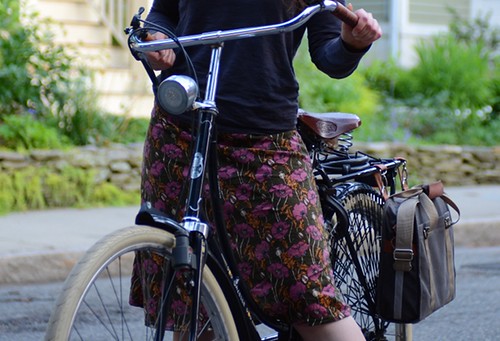
The bike's weight however, does not pose a problem when the Gazelle is in motion. It accelerates easily and retains momentum extremely well. On flats I can fairly quickly get it to 17mph+ in the high gear, which is about as fast as I'd want to go in the city anyhow.
Uphill is of course a different story, though it's not quite as bad as you might think just by looking at the bike. Uphill the Gazelle is slow, but responsive to hard pedaling effort. Unlike some other heavy city bikes, it does not attempt to pull me back, but is willing to advance slowly forward and upward as long as I am willing to push.

Having had the bike out of sight for so long, it was also nice to see its lovely little details again. Being of mid-90s production, the bike is not exactly "vintage," but still the details were more nuanced on these older models than they are today. Examining all the intricate, albeit now rusty, little embellishments on it is a pleasure. The bike was well used before I got my hands on it, and spent a great portion of its life outdoors as I understand it. In light of that history, the extent to which its functionality and aesthetics have been preserved is impressive.
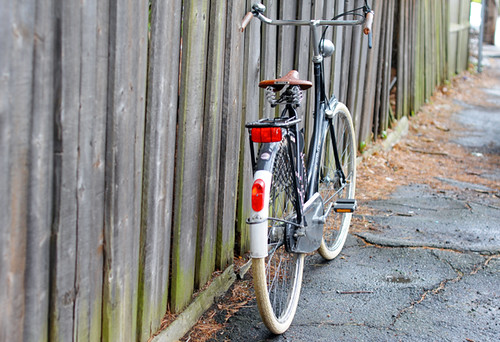
While I love and respect the Gazelle, for my current transportation needs I've come to prefer a more active ride and a slightly more aggressive posture. Still, the positive qualities of this bicycle are hard to beat.
The Dutch bike is an excellent choice for a cyclist who wants to be as upright and relaxed as possible, enjoys a plush ride, prefers to do little to no maintenance on their bicycle even in winter, lives in a fairly flat environment, and is undaunted by weight. It will also appeal to those who love vintage elegance: The basic design of the Dutch bike has gone largely unchanged over the past century and remains an icon of transportation cycling.
Sunday, December 6, 2009
No, it's REALLY raining up here
The southside of the park is closed; the rain has started to wash out or significantly threaten a number of roads and access points. For updated information about weather and access, call 360 569 2211 and press ext 9.
 Updates: the weather observations for Paradise measured 11.3 inches in the past 24 hours! At Camp Muir, the temps hovered in the mid 30's (probably rain) but it was the wind speed that remained impressive. Gusts of 121 MPH were recorded and the average wind speed for one hour in midday was 101!! The Nisqually River (pictured right) is nothing short of a boiling chocolately torrent, as is every other creek and stream around here. The river sounds like a freight train and the ground trembles as large boulders and old-growth trees jostle into the flow. The air even smells of glacial mud, cedar and pine.
Updates: the weather observations for Paradise measured 11.3 inches in the past 24 hours! At Camp Muir, the temps hovered in the mid 30's (probably rain) but it was the wind speed that remained impressive. Gusts of 121 MPH were recorded and the average wind speed for one hour in midday was 101!! The Nisqually River (pictured right) is nothing short of a boiling chocolately torrent, as is every other creek and stream around here. The river sounds like a freight train and the ground trembles as large boulders and old-growth trees jostle into the flow. The air even smells of glacial mud, cedar and pine.
As it stands now, the NPS is evacuating any non-essential personnel from the park before the roads completely wash out. The Carbon River road is also closed, as is the rest of the park.
 Updates: the weather observations for Paradise measured 11.3 inches in the past 24 hours! At Camp Muir, the temps hovered in the mid 30's (probably rain) but it was the wind speed that remained impressive. Gusts of 121 MPH were recorded and the average wind speed for one hour in midday was 101!! The Nisqually River (pictured right) is nothing short of a boiling chocolately torrent, as is every other creek and stream around here. The river sounds like a freight train and the ground trembles as large boulders and old-growth trees jostle into the flow. The air even smells of glacial mud, cedar and pine.
Updates: the weather observations for Paradise measured 11.3 inches in the past 24 hours! At Camp Muir, the temps hovered in the mid 30's (probably rain) but it was the wind speed that remained impressive. Gusts of 121 MPH were recorded and the average wind speed for one hour in midday was 101!! The Nisqually River (pictured right) is nothing short of a boiling chocolately torrent, as is every other creek and stream around here. The river sounds like a freight train and the ground trembles as large boulders and old-growth trees jostle into the flow. The air even smells of glacial mud, cedar and pine. As it stands now, the NPS is evacuating any non-essential personnel from the park before the roads completely wash out. The Carbon River road is also closed, as is the rest of the park.
Subscribe to:
Posts (Atom)